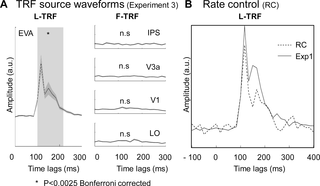PLOS Biology ( IF 9.8 ) Pub Date : 2017-11-30 , DOI: 10.1371/journal.pbio.2003646 Ling Liu , Fan Wang , Ke Zhou , Nai Ding , Huan Luo

|
Rapidly grouping local elements into an organized object (i.e., perceptual integration) is a fundamental yet challenging task, especially in noisy contexts. Previous studies demonstrate that ventral visual pathway, which is widely known to mediate object recognition, engages in the process by conveying object-level information processed in high-level areas to modulate low-level sensory areas. Meanwhile, recent evidence suggests that the dorsal visual pathway, which is not typically attributable to object recognition, is also involved in the process. However, the underlying whole-brain fine spatiotemporal neuronal dynamics remains unknown. Here we used magnetoencephalography (MEG) recordings in combination with a temporal response function (TRF) approach to dissociate the time-resolved neuronal response that specifically tracks the perceptual grouping course. We demonstrate that perceptual integration initiates robust and rapid responses along the dorsal visual pathway in a reversed hierarchical manner, faster than the ventral pathway. Specifically, the anterior intraparietal sulcus (IPS) responds first (i.e., within 100 ms), followed by activities backpropagating along the dorsal pathway to early visual areas (EVAs). The IPS activity causally modulates the EVA response, even when the global form information is task-irrelevant. The IPS-to-EVA response profile fails to appear when the global form could not be perceived. Our results support the crucial function of the dorsal visual pathway in perceptual integration, by quickly extracting a coarse global template (i.e., an initial object representation) within first 100 ms to guide subsequent local sensory processing so that the ambiguities in the visual inputs can be efficiently resolved.
中文翻译:

知觉整合迅速激活背侧视觉通路,以指导早期视觉区域的局部处理
将局部元素快速分组为一个有组织的对象(即感知整合)是一项基本而又具有挑战性的任务,尤其是在嘈杂的环境中。先前的研究表明,腹侧视觉通路是众所周知的介导对象识别的途径,它通过传达在高层区域中处理的对象水平信息来调节低层感觉区域,从而参与了这一过程。同时,最近的证据表明,通常不归因于物体识别的背侧视觉通路也参与了该过程。然而,潜在的全脑精细时空神经元动力学仍然未知。在这里,我们结合了脑磁图(MEG)记录和时间响应功能(TRF)方法来分离时间分辨的神经元反应,该反应具体地跟踪了感知分组过程。我们证明,知觉整合沿着背侧视觉通路以相反的分层方式启动了强大而快速的反应,比腹侧通路更快。具体而言,前顶壁沟(IPS)首先(即在100毫秒内)作出反应,然后是沿着背侧路径向后传播到早期视觉区域(EVA)的活动。即使全局表单信息与任务无关,IPS活动也会因果调节EVA响应。当无法感知全局形式时,IPS到EVA响应配置文件不会出现。



























 京公网安备 11010802027423号
京公网安备 11010802027423号